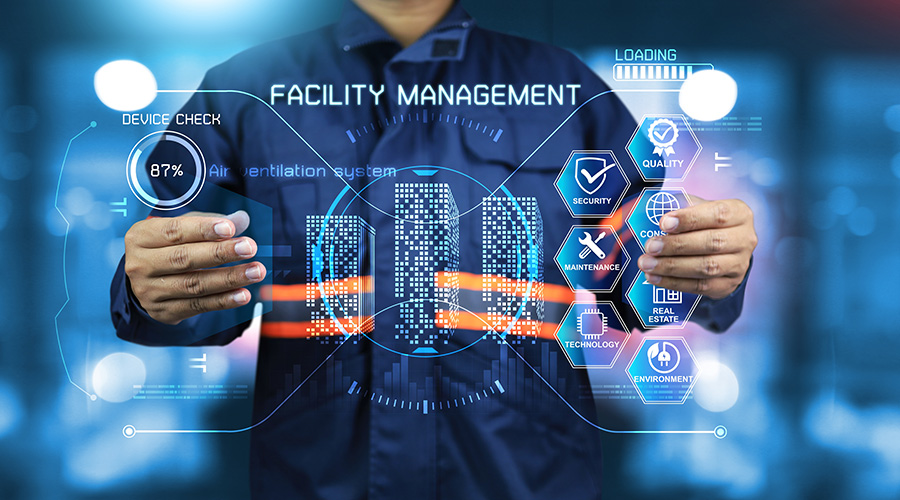Trick Fads Shaping the Future of Facility Management in 2024
As we look in advance to 2024, the landscape of center management is positioned for substantial change, driven by a number of crucial patterns. The assimilation of smart structure innovations and a change in the direction of data-driven decision-making guarantee to enhance functional effectiveness while focusing on sustainability in technique.
Smart Building Technologies

Smart structure modern technologies encompass a wide range of systems, including smart lighting, heating and cooling controls, and safety and security systems. By incorporating these systems, center managers can check and adjust parameters in real-time, leading to significant reductions in energy waste and functional prices. For example, wise sensing units can identify occupancy degrees and change lights and temperature level as necessary, making certain that power is just made use of when essential.
Furthermore, these technologies promote boosted information collection, permitting companies to track usage patterns and identify possibilities for additional improvements. The execution of wise structure technologies not only contributes to sustainability goals yet likewise creates much healthier work atmospheres that can improve worker productivity and complete satisfaction.
As we move right into 2024, the fostering of smart structure innovations will likely speed up, showing a wider change towards even more intelligent, responsive, and sustainable center management techniques.
Data-Driven Decision Making
Increasingly, organizations are leveraging data-driven decision making to improve facility administration techniques. By utilizing information analytics, center managers can acquire workable insights that dramatically boost operational performance and source allotment. The integration of innovative technologies, such as IoT sensing units and real-time monitoring systems, allows the collection of substantial amounts of information on structure performance, occupancy prices, and power consumption.
This riches of details enables facility managers to recognize trends, predict upkeep demands, and proactively address problems before they rise. For example, predictive analytics can forecast tools failings, decreasing downtime and repair service prices. Furthermore, data visualization tools facilitate better interaction amongst stakeholders, making certain that educated choices are made collaboratively.
In addition, data-driven techniques improve calculated preparation by making it possible for center supervisors to analyze the performance of existing methods and make educated choices concerning investments in modern technology or facilities. As organizations increasingly focus on operational quality, data-driven choice making is poised to come to be a foundation of effective facility administration strategies in 2024 and past. Ultimately, the capability to leverage data effectively will encourage organizations to create much more effective, efficient, and resilient facilities.
Sustainability and Environment-friendly Practices
The learn this here now emphasis on data-driven choice making normally straightens with the expanding concentrate on sustainability and green techniques within center administration. As companies increasingly prioritize environmental responsibility, center supervisors are leveraging analytics to maximize resource use, lower waste, and lessen carbon footprints. This strategic strategy allows the integration of energy-efficient systems, such as LED lights, wise heating and cooling controls, and renewable resource sources right into facility procedures.
In addition, the application of sustainable techniques extends past energy intake. Facility supervisors are advertising and embracing green materials reusing efforts to develop a circular economy within their facilities. This not only improves the environmental profile of the company but additionally fosters a society of sustainability amongst workers.
Conformity with environmental guidelines is an additional important aspect driving the adoption of environment-friendly practices. By using information analytics, facility managers can monitor conformity metrics and recognize locations for improvement, making certain adherence to worldwide and local sustainability standards.
Crossbreed Job Designs
A considerable change towards hybrid job versions is improving the landscape of facility monitoring in 2024. This paradigm incorporates in-office and remote work, demanding a reevaluation of area utilization, source allotment, and worker interaction strategies. Organizations are significantly acknowledging the importance of flexible work spaces that cater to diverse needs and choices.
Center managers have to adjust by executing versatile workplace layouts that support joint initiatives while supplying areas for focused work. This consists of the combination of innovation to facilitate smooth interaction and collaboration amongst remote and in-office workers. Smart structure options, geared up with sensors and analytics, allow for real-time tracking of room use, making it possible for companies to optimize their settings successfully.
Moreover, crossbreed work models highlight the demand for effective facility monitoring click here for info that focuses on staff member experience. In essence, the crossbreed work model is transforming facility monitoring, motivating a proactive approach to fulfill the evolving needs of the labor force.
Improved Resident Wellness
As organizations welcome hybrid work models, a heightened emphasis on passenger wellness is ending up being essential to facility management techniques. Facility Management. This change recognizes that a great site healthy and satisfied workforce straight affects efficiency and retention prices. Facility supervisors are now focusing on settings that promote psychological and physical well-being, incorporating elements such as natural lights, biophilic layout, and available wellness sources
Modern technology plays a vital role in this development. Smart structure systems can keep an eye on environmental variables and readjust settings in real-time, making certain optimal convenience degrees - Facility Management. Comments mechanisms, such as tenancy sensors and employee studies, enable center managers to consistently refine wellness campaigns based on passenger requirements.

Conclusion
In 2024, the future of facility monitoring will certainly be significantly affected by the assimilation of wise structure modern technologies and data-driven decision-making, promoting improved functional performance. These fads jointly underscore the evolving landscape of center management in feedback to modern obstacles and possibilities.
Center supervisors are adopting eco-friendly products and promoting reusing initiatives to develop a round economic climate within their centers.A considerable shift in the direction of crossbreed job versions is reshaping the landscape of facility monitoring in 2024.Additionally, hybrid work versions highlight the need for reliable center management that focuses on employee experience.As organizations embrace hybrid job models, an enhanced emphasis on owner wellness is coming to be integral to center management techniques.In 2024, the future of center administration will certainly be dramatically affected by the combination of smart building modern technologies and data-driven decision-making, promoting enhanced functional performance.